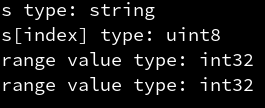全面认识golang string
string我们每天都在使用,可是对于string的细节问题你真的了解吗?
今天我们先以一个问题开篇。
你能猜到下面代码的输出吗?
package main import ( "fmt" ) func main() { s := "测试" fmt.Println(s) fmt.Println(len(s)) fmt.Println(s[0]) for _, v := range s { fmt.Println(v) } }
谜底揭晓:

是不是觉得很奇怪?明明是2个汉字,为啥长度是6?为啥s[0]是个数字,又为啥长度是6却只循环了两次,而且输出的也是数字?
别急,我们一个个地说明。
string的真实长度
要知道string的长度,首先要知道string里到底存了什么,我们看下官方的文档:
type string string
string is the set of all strings of 8-bit bytes, conventionally but not
necessarily representing UTF-8-encoded text. A string may be empty, but not
nil. Values of string type are immutable.
是的,没看错,在string里存储的是字符按照utf8编码后的“8-bit bytes”二进制数据,再说得明确点,就是我们熟悉的byte类型:
type byte = uint8
byte is an alias for uint8 and is equivalent to uint8 in all ways. It is
used, by convention, to distinguish byte values from 8-bit unsigned integer
values.
我们都知道,utf8在表示中文时需要2个字节以上的空间,这里我们一个汉字是3字节,所以总长度就是我们直接用len得到的6。
从string中索引到的值
从string里使用索引值得到的数据也是byte类型的,所以才会输出数字,最好的证据在于此(最后还会有证明代码),还记得byte的文档吗:
type byte = uint8
如果看不懂,没关系,这是golang的type alias语法,相当于给某个类型起了个别名,而不是创建了新类型,所以byte就是uint8。
所以,输出uint8类型的数据,那么自然会看到数字。
range string时发生了什么?
那么range的情况呢,长度是,为什么只循环两次?
首先我们可以排除byte了,uint8怎么可能会有20000的值。
然后我们来看一下官方文档,其中有这么一段:
For strings, the range does more work for you, breaking out individual Unicode code points by parsing the UTF-8. Erroneous encodings consume one byte and produce the replacement rune U+FFFD. (The name (with associated builtin type) rune is Go terminology for a single Unicode code point. See the language specification for details.) The loop
有点长,大致意思就是range会把string里的byte重新转换成utf8字符,对于错误的编码就用一字节的占位符替代,这下清楚了,range实际上和如下代码基本等价:
for _, v := range []rune(s)
我们是字符串正好是2个utf8字符,所以循环输出两次。我们再看看看看rune的文档:
type rune = int32
rune is an alias for int32 and is equivalent to int32 in all ways. It is
used, by convention, to distinguish character values from integer values.
rune是int32的别名,它的值是Unicode码点,所以当我们println时就看到了数字。
代码验证
虽然没什么必要,但我们还是可以通过代码不算太严谨地验证一下我们得到的结论,想获取变量的类型,使用reflect.TypeOf即可(无法获取别名,所以“不严谨”):
package main import ( "fmt" "reflect" ) func main() { s := "测试" fmt.Println("s type:", reflect.TypeOf(s)) fmt.Println("s[index] type:", reflect.TypeOf(s[0])) for _, v := range s { fmt.Println("range value type:", reflect.TypeOf(v)) } }

与我们预想的一样,uint8是byte,int32是rune,虽然TypeOf无法输出类型别名,但我们还是可以粗略判断出它的类型名称。
通过这篇文章,我们已经对string类型有了全面的认知。
如有错误欢迎指正!






